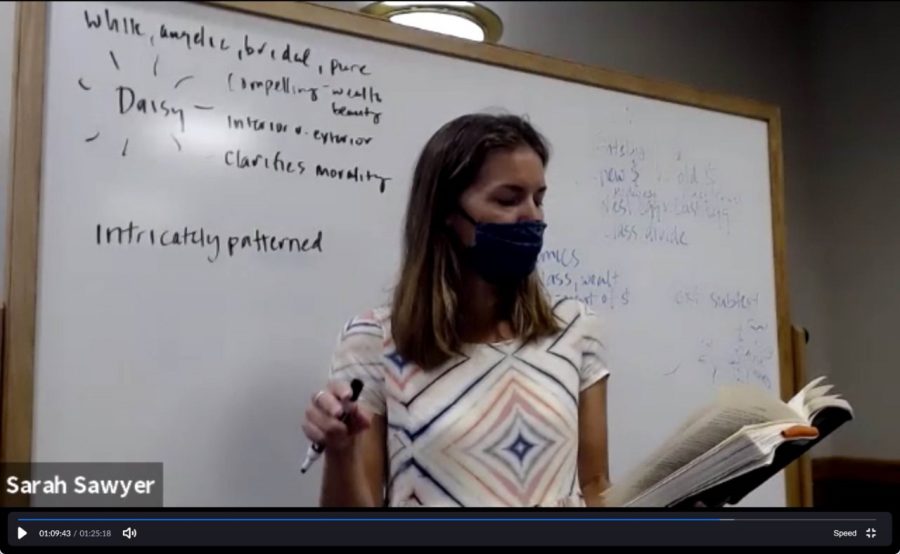Remote Learners Reflect on Zoom Experience
Due to the Covid-19 global pandemic in 2020, Williston students who cannot go back to campus this fall are taking classes online using Zoom. The experience, some remote learners say, is very different from being in the classroom.
Dangers of the Covid-19 and travel restrictions made it hard — or impossible — for international students in Williston to get back on campus. To ensure these students’ academic experience is on par with those in person, teachers at Williston in the fall of 2020 are teaching with a “hybrid” model: students in a classroom and students on Zoom at the same time.
The Covid-19 pandemic started in December 2019, in Wuhan, China, and reached the United States in January 2020. By the end of March, lockdowns started in the United States; Williston students did not return to campus after their spring break.
After one trimester of online classes and three months of summer break, most Williston students were able to go back to campus, and as of Sept. 19, there are zero reported Covid positive cases on campus.
However, it is inconvenient and risky for international students to get back to Williston. For example, mainland Chinese students have to be quarantined in another country for 14 days before entering the U.S.
One popular country for Chinese students to quarantine is Cambodia. However, after quarantining, they have to transfer flights in Korea or Japan to the U.S. and quarantine at school for another 14 days.
Some students report that taking online classes is a struggle because they either have to miss classes or stay up until or after midnight due to time differences. Many students said they are having trouble joining class discussions because it is hard for the teachers to call on students in the classroom and online at the same time.
Weak internet connection has also caused many students to disruptions or disconnections from Zoom classes. Zoom suspended all direct sales to mainland China on August 23, which prevented users from signing up new accounts, according to an Aug. 3 Forbes article. Because of that, some Chinese students have had trouble getting into the Zoom meeting rooms that required users to sign in before joining.
One way to access Zoom is if users have signed up for a non-Chinese account before August 23, for example, using email, Google, and Facebook, they could use VPN and log in from those routes. The other way is if they sign-up for a Chinese zoom account before August 23 using WeChat or Alipay, they can download the local version from zoom-china.com and log in. However, Chinese accounts can no longer host meetings since May 20th.
Sophie Calderon, a two-year senior from Brazil, believes that the teachers are doing their best in this situation, assisting the remote students and accommodating to the situation. “I think teachers are managing the situation the best they can,” she said, “And they have been very accessible and flexible with remote students.”
However, for her, classes are not always perfect.
“Classes are not ideal,” she said. She said that it has been difficult to hear or communicate with her classmates on Zoom in classes but does not intend to complain about the situation. “I wish I could hear my friends, understand what they say, laugh with them,” she said, “but it’s not too bad and I appreciate all the effort put into it.”
Adding on to that, she thinks that the resource centers in school that help students academically in school are hard to access and not as helpful for the remote students. “I think that the resource centers are the least accessible to remote kids,” she said, “I don’t know why but I don’t really feel like I can get good help from them.”
Anita Hua, a three-year junior from Shanghai, China, likes the Zoom classes better. Similar to Sophie, she thinks that Zoom the best option considering the situation. “The Zoom classes are okay. They are the best way to teach remote learners,” she said. “There are tech issues for sure but that doesn’t really stop it from being a good choice of learning remotely.”
Praghya Athavan Raja, a three-year junior from India who is working remotely from Saudi Arabia, does not like the online classes much because it is a challenging experience for her when she is away from her classmates. “I personally don’t like online school/classes especially when most students are in the classroom,” she said. “I just think it’s very hard for me to learn, ask questions, and participate.”
Yafei Zhou, a first-year freshman from China who goes by Mayphia, gave a detailed report on her struggles during her first experience at Williston. She thinks it made the situation awkward when remote students miss class because of the time difference and there is no recording of the class. “Sometimes when the teachers were not on Zoom, there won’t be a recording, which would be awkward,” she said.
“When it’s one or two o’clock in the morning for us Chinese students, we’ve all went to sleep,” she added. “It’s like we’re missing the whole class, which is depressing. If the whole class is about important notes that we have to memorize, it would be a huge loss.”
She pointed out that answering questions and understanding what other students are saying is difficult, but some teachers do it better. “I’m confused about whom the teacher is actually calling on, and what they are doing on the other side.”
She continued, “I have never heard clearly what other students are saying. When I finally got what they were saying, the teachers were already moving on to the next question. Some teachers are very nice, and they repeat their questions.”











